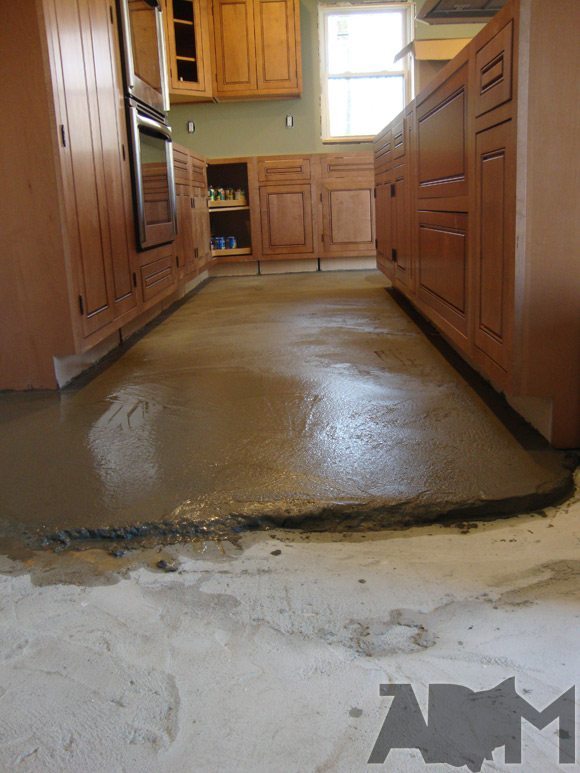Have you ever walked into a room and felt your feet tilting like you’re on a pirate ship? Uneven floors can be more than an annoyance, they can lead to furniture instability, tripping hazards, and even structural problems down the road. But can you simply grab a bag of concrete mix from the hardware store and pour it over your uneven floor? The answer, as with most DIY projects, is: it depends.

Image: www.pinterest.com
Leveling a floor can significantly impact the comfort and functionality of your home. Understanding your options, including the limitations and considerations of using regular concrete, is crucial to making the best decision for your situation. Let’s dive into the world of floor leveling and discover if regular concrete is your knight in shining armor or a recipe for disaster.
The Basics of Floor Leveling
Before we get into the nitty-gritty of regular concrete, let’s refresh our understanding of floor leveling. Essentially, it’s the process of adjusting an uneven floor surface to create a smooth and level platform. This can be achieved using various materials and techniques, each with its own pros and cons.
Examining the Use of Regular Concrete
Regular concrete, often referred to as “Portland cement concrete”, is a versatile material known for its durability and strength. It’s commonly used for foundations, sidewalks, and driveways, but it’s not always the ideal choice for indoor floor leveling. Here’s why:
- Thickness: Regular concrete is designed for thick pours, often several inches deep. If you only need a thin layer for smoothing out minor imperfections, it’s likely too thick and may not cure properly.
- Shrinkage and Cracking: Regular concrete can shrink as it dries, potentially leading to cracks that disrupt the level you’ve achieved.
- Workability: While regular concrete can be workable, it tends to be dense and difficult to spread evenly over small areas. This can make achieving a seamless, smooth finish challenging.
- Time and Cost: Working with regular concrete requires more time and often specific tools and expertise. It needs proper curing time, which can significantly delay your project.
When Regular Concrete Might be Suitable
While regular concrete isn’t always the best choice for indoor floor leveling, there are situations where it might be appropriate:
- Significant Unevenness: If you’re dealing with a floor that’s significantly uneven, regular concrete’s strength and durability might be necessary for proper support and leveling.
- Large Areas: For large areas, regular concrete can be more economical than other leveling solutions.
- Outdoor Projects: When leveling concrete patios or other outdoor surfaces, regular concrete is a suitable and durable option.

Image: www.akronohiomoms.com
Choosing the Right Material for Your Project
If you’re unsure about using regular concrete for your floor leveling project, consider these alternatives:
- Self-Leveling Concrete: This pre-mixed formula is specifically designed for thin layers and self-levels as it dries. It’s ideal for minor unevenness and achieving a smooth finish.
- Leveling Compound: This powder-based material mixes with water to create a paste that can be applied in thin layers to level floors. It’s flexible and dries quickly, making it suitable for smaller projects.
- Floor Screed: This is a concrete-based mixture that’s poured and then smoothed using a screed tool to achieve a level surface. It’s typically used for larger areas and requires specialized equipment and expertise.
Expert Insights: A DIY vs. Professional Perspective
While some DIY projects are achievable for the average homeowner, floor leveling often requires specialized knowledge and tools. Here’s what experts recommend:
- Minor Unevenness: For minor imperfections, a self-leveling compound or thin-set mortar might be sufficient. For these projects, DIY is often feasible.
- Significant Unevenness: If you’re dealing with a floor that’s significantly uneven or have a complex layout, seeking professional help is recommended. Experts can ensure proper preparation, material selection, and application techniques.
Tips for a Successful Floor Leveling Project
Whether you choose to DIY or hire a professional, keep these tips in mind for a successful floor leveling project:
- Thorough Preparation: Ensure the existing floor is clean, free of debris, and properly primed for the leveling material.
- Proper Mixing: Carefully follow the manufacturer’s instructions for mixing and applying the leveling compound or concrete.
- Even Distribution: Spread the material evenly to ensure a level surface. Use a trowel or screed tool to smooth it out.
- Curing Time: Allow the leveling material sufficient drying and curing time to fully harden. Avoid applying pressure or foot traffic during this phase.
- Finishing Touches: After curing, you can typically sand or polish the floor to achieve a smooth finish.
Can I Use Regular Concrete To Level A Floor
Conclusion
Leveling a floor can be a rewarding project, improving the functionality and aesthetics of your home. While regular concrete can be suitable for significant unevenness or large outdoor areas, it’s not always the best choice for indoor projects requiring thin layers. Exploring alternative materials like self-leveling concrete or leveling compound, and consulting professional assistance for complex projects, will lead to optimal results. Remember, taking the time to carefully choose the right materials and follow expert guidance will ensure your floor leveling project is a success, turning a ship-like feeling into a smooth and steady foundation.






